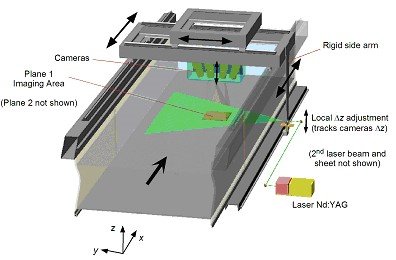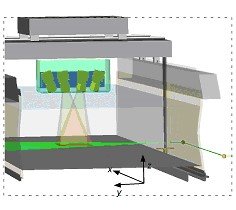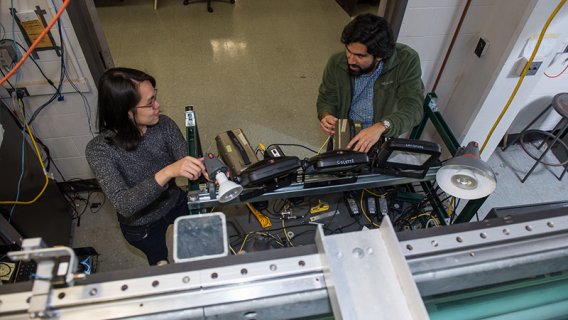Turbulent Water Channel and Flying PIV System
Director: E. Longmire
Location: 30A Akerman Hall
Professors Ivan Marusic and Ellen Longmire (Aerospace Engineering and Mechanics) and Victoria Interrante (Computer Science) were awarded an NSF grant of $1.25 million over 4 years titled "Dynamic Methods for Indentifying, Visualizing and Tracking Eddy Evolution in Experimental Turbulent Flows." Over the past 10 years Professor Ivan Marusic has been actively working on the problem of understanding turbulent flows. This NSF sponsored project involves a cross-disciplinary approach, uniting an expert in data visualization (Victoria Interrante) with experts in experimental fluid mechanics (Marusic and Longmire), to tackle the problem of understanding the dynamic evolution of key physical mechanisms in turbulent flows. These flows, which are of great practical importance in a large number of fields, have remained a challenging area of research for over 100 years. One example application is the skin-friction drag experienced on aircraft. Here the boundary layer turbulence accounts for the largest operating cost in commercial flights through increased fuel usage.


Experimental set-up: Particle Image Velocimetry (PIV) system is traversed down the length of a water channel dynamically tracking and acquiring data of turbulent flow structures
The proposed experiments involve tracking in real time "vortex packets", structures that have been identified only recently by Professors Marusic and Longmire and others as a key mechanism in the skin-friction drag producing events in these flows. A dual stereo-PIV system (with accompanying laser sheets) are traversed along the length of a water channel flow using a gantry robot mechanism and implementing a feature detection scheme dependent on the visualization tools to generate a feedback signal. The customized particle image velocimetry (PIV) system provides three-dimensional velocity field data in two parallel planes. The correlations between the planes can be visualized to gain insight into the three-dimensional nature of the features. In addition, two closely-spaced planes allow an evaluation of the full velocity gradient tensor. Such information is needed in order to characterize the topological nature of the instantaneous flow patterns. The resulting experiments and feature extraction strategies aim to provide answers to unique and challenging questions about the generation, development, merging and interaction, and breakdown of vortex packet structures and other dominant flow features in wall turbulence.
The project also focuses on the development of multivariate visualization methods appropriate for the type of data set (three-dimensional data in two-dimensional planes) that the experiments generate. Special attention is paid to quantifying how and why different visual features, such as color, texture, topography, and motion, work to convey information efficiently and effectively. It is hoped that these tools will find general application in a wide range of practical problems.
